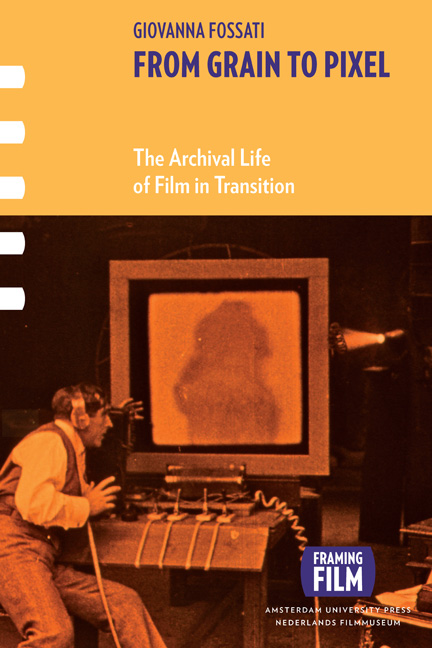Book contents
- Frontmatter
- Deduction
- Contents
- Acknowledgements
- Framing Film (in Transition): an Introduction
- Practice and Theory of (Archival) Film
- Theorizing (Archival) Practice
- A New Mindset for (Archival) Film in Transition: a Conclusion
- Notes
- Glossary Of Technical Terms
- List of Illustrations
- Filmography
- Bibliography
- Index
Chapter One - Film Practice in Transition
Published online by Cambridge University Press: 16 February 2021
- Frontmatter
- Deduction
- Contents
- Acknowledgements
- Framing Film (in Transition): an Introduction
- Practice and Theory of (Archival) Film
- Theorizing (Archival) Practice
- A New Mindset for (Archival) Film in Transition: a Conclusion
- Notes
- Glossary Of Technical Terms
- List of Illustrations
- Filmography
- Bibliography
- Index
Summary
In this chapter I will describe and discuss the main changes that are taking place in film archival practices today, from preservation to exhibition and access, as a result of the introduction of digital technology. While doing so, I will introduce links with the changes in theoretical approaches within current film and new media theory, which, in turn, will be central in the following chapter.
The objective of the following pages is to provide a snapshot of the current practices in film archiving, focusing, in particular, on the changes brought about by the introduction of digital tools. A detailed snapshot of archival practice in transition is necessary at this point since it is missing in the literature at the time of writing, and it is meant to serve as a reference for those who are not familiar with the techniques involved in preservation, restoration and exhibition of archival films as carried out today. Within this work it also serves as a technical reference for the case studies discussed.
Furthermore, a snapshot of the technology available and the practices adopted by film archives today is instrumental in placing this work within the very transition it discusses. Archival practice is in many ways connected to film production practice. The most evident connection between archives and the film industry is that they make use of the same service providers (e.g. the same film manufacturers and laboratories) and of the same equipment for exhibition (e.g. projectors and sound systems). As a consequence, archivists need to know the technology used to make films today in order to be able to best preserve and restore these films tomorrow. Being familiar with current changes in film production practices is also necessary for film archivists in order to understand where changes in archival practices originate from and where they might be headed. Understanding the transition in the film medium is, indeed, the very first step for rethinking film museums of the future.
With the above in mind, in the first part of this chapter, I will discuss a number of areas of contemporary filmmaking where the use of digital tools can clearly be held responsible for significant changes in the film production workflow.
- Type
- Chapter
- Information
- From Grain to PixelThe Archival Life of Film in Transition, pp. 33 - 102Publisher: Amsterdam University PressPrint publication year: 2018



